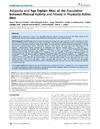Identificador persistente para citar o vincular este elemento:
https://accedacris.ulpgc.es/jspui/handle/10553/4712
| Título: | Adiposity and age explain most of the association between physical activity and fitness in physically active men | Autores/as: | Serrano-Sánchez, José A. Delago-Guerra, Safira Olmedillas, Hugo Guadalupe-Grau, Amelia Arteaga Ortiz, Rafael Ángel Sanchis-Moysi, Joaquín Dorado, Cecilia Calbet, José A.L. |
Clasificación UNESCO: | 32 Ciencias médicas 610605 Niveles de actividad 241106 Fisiología del ejercicio |
Palabras clave: | Fat Obesity Fitness |
Fecha de publicación: | 2010 | Publicación seriada: | PLoS ONE | Resumen: | BACKGROUND: To determine if there is an association between physical activity assessed by the short version of the International Physical Activity Questionnaire (IPAQ) and cardiorespiratory and muscular fitness. METHODOLOGY/PRINCIPAL FINDINGS: One hundred and eighty-two young males (age range: 20-55 years) completed the short form of the IPAQ to assess physical activity. Body composition (dual-energy X-Ray absorptiometry), muscular fitness (static and dynamic muscle force and power, vertical jump height, running speed [30 m sprint], anaerobic capacity [300 m running test]) and cardiorespiratory fitness (estimated VO(2)max: 20 m shuttle run test) were also determined in all subjects. Activity-related energy expenditure of moderate and vigorous intensity (EEPA(moderate) and EEPA(vigorous), respectively) was inversely associated with indices of adiposity (r = -0.21 to -0.37, P<0.05). Cardiorespiratory fitness (VO(2)max) was positively associated with LogEEPA(moderate) (r = 0.26, P<0.05) and LogEEPA(vigorous) (r = 0.27). However, no association between VO(2)max with LogEEPA(moderate), LogEPPA(vigorous) and LogEEPA(total) was observed after adjusting for the percentage of body fat. Multiple stepwise regression analysis to predict VO(2)max from LogEEPA(walking), LogEEPA(moderate), LogEEPA(vigorous), LogEEPA(total), age and percentage of body fat (%fat) showed that the %fat alone explained 62% of the variance in VO(2)max and that the age added another 10%, while the other variables did not add predictive value to the model [VO(2)max = 129.6-(25.1x Log %fat) - (34.0x Log age); SEE: 4.3 ml.kg(-1). min(-1); R(2) = 0.72 (P<0.05)]. No positive association between muscular fitness-related variables and physical activity was observed, even after adjusting for body fat or body fat and age. CONCLUSIONS/SIGNIFICANCE: Adiposity and age are the strongest predictors of VO(2)max in healthy men. The energy expended in moderate and vigorous physical activities is inversely associated with adiposity. Muscular fitness does not appear to be associated with physical activity as assessed by the IPAQ. | URI: | https://accedacris.ulpgc.es/handle/10553/4712 | ISSN: | 1932-6203 | DOI: | 10.1371/journal.pone.0013435 | Fuente: | PLoS ONE [1932-6203], n. 5 (e13435) | Derechos: | by-nc-sa |
| Colección: | Artículos |
Citas SCOPUSTM
16
actualizado el 08-jun-2025
Citas de WEB OF SCIENCETM
Citations
15
actualizado el 12-ene-2026
Visitas 5
231
actualizado el 10-ene-2026
Descargas
61
actualizado el 10-ene-2026
Google ScholarTM
Verifica
Altmetric
Comparte
Exporta metadatos
Los elementos en ULPGC accedaCRIS están protegidos por derechos de autor con todos los derechos reservados, a menos que se indique lo contrario.
